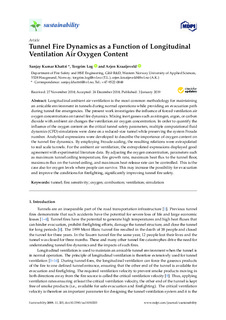| dc.contributor.author | Khattri, Sanjay Kumar | |
| dc.contributor.author | Log, Torgrim | |
| dc.contributor.author | Kraaijeveld, Arjen | |
| dc.date.accessioned | 2019-06-06T08:58:48Z | |
| dc.date.available | 2019-06-06T08:58:48Z | |
| dc.date.created | 2019-01-03T10:12:01Z | |
| dc.date.issued | 2019 | |
| dc.identifier.citation | Khattri, S. K., Log, T., & Kraaijeveld, A. (2019). Tunnel fire dynamics as a function of longitudinal ventilation air oxygen content. Sustainability, 11(1). | nb_NO |
| dc.identifier.issn | 2071-1050 | |
| dc.identifier.uri | http://hdl.handle.net/11250/2600087 | |
| dc.description.abstract | Longitudinal ambient air ventilation is the most common methodology for maintaining an amicable environment in tunnels during normal operations while providing an evacuation path during tunnel fire emergencies. The present work investigates the influence of forced ventilation air oxygen concentrations on tunnel fire dynamics. Mixing inert gasses such as nitrogen, argon, or carbon dioxide with ambient air changes the ventilation air oxygen concentration. In order to quantify the influence of the oxygen content on the critical tunnel safety parameters, multiple computational fluid dynamics (CFD) simulations were done on a reduced-size tunnel while preserving the system Froude number. Analytical expressions were developed to describe the importance of oxygen content on the tunnel fire dynamics. By employing Froude scaling, the resulting relations were extrapolated to real scale tunnels. For the ambient air ventilation, the extrapolated expressions displayed good agreement with experimental literature data. By adjusting the oxygen concentration, parameters such as maximum tunnel ceiling temperature, fire growth rate, maximum heat flux to the tunnel floor, maximum flux on the tunnel ceiling, and maximum heat release rate can be controlled. This is the case also for oxygen levels where people can survive. This may increase the possibility for evacuation and improve the conditions for firefighting, significantly improving tunnel fire safety. | nb_NO |
| dc.language.iso | eng | nb_NO |
| dc.publisher | MDPI | nb_NO |
| dc.rights | Navngivelse 4.0 Internasjonal | * |
| dc.rights.uri | http://creativecommons.org/licenses/by/4.0/deed.no | * |
| dc.subject | tunnel | nb_NO |
| dc.subject | fire | nb_NO |
| dc.subject | sensitivity | nb_NO |
| dc.subject | oxygen | nb_NO |
| dc.subject | combustion | nb_NO |
| dc.subject | ventilation | nb_NO |
| dc.subject | simulation | nb_NO |
| dc.title | Tunnel Fire Dynamics as a Function of Longitudinal Ventilation Air Oxygen Content | nb_NO |
| dc.type | Journal article | nb_NO |
| dc.type | Peer reviewed | nb_NO |
| dc.description.version | publishedVersion | nb_NO |
| dc.rights.holder | © 2019 by the authors. | nb_NO |
| dc.source.pagenumber | 13 | nb_NO |
| dc.source.volume | 11 | nb_NO |
| dc.source.journal | Sustainability | nb_NO |
| dc.source.issue | 1 | nb_NO |
| dc.identifier.doi | 10.3390/su11010203 | |
| dc.identifier.cristin | 1649237 | |
| cristin.unitcode | 203,12,2,0 | |
| cristin.unitname | Institutt for brannsikkerheit og HMS | |
| cristin.ispublished | true | |
| cristin.fulltext | original | |
| cristin.qualitycode | 1 | |

